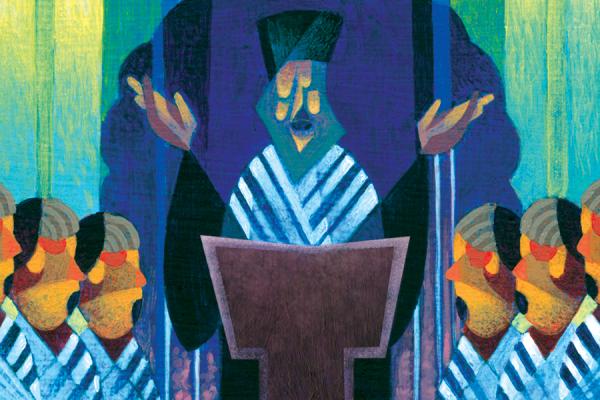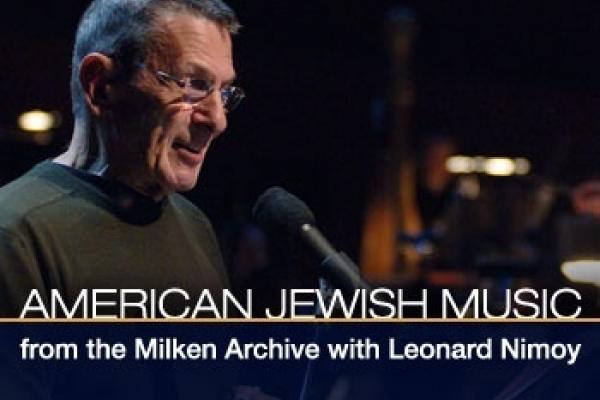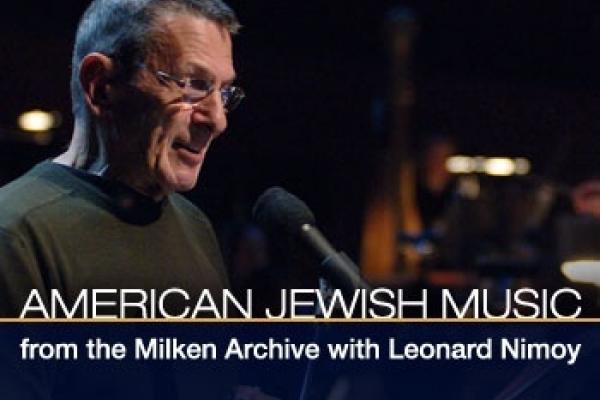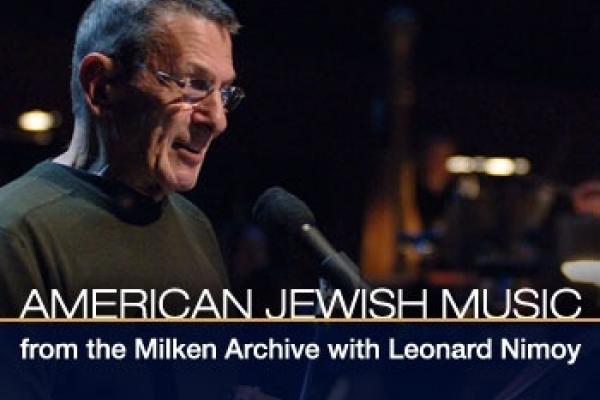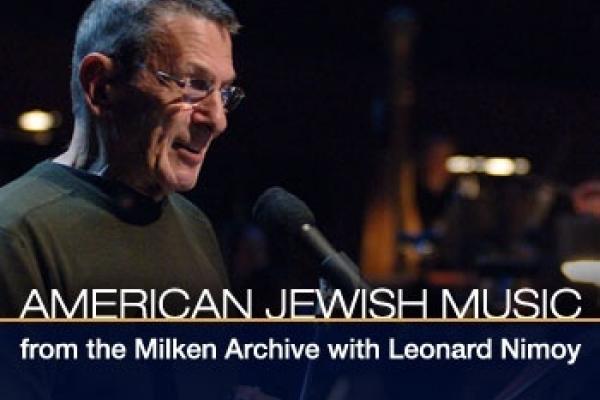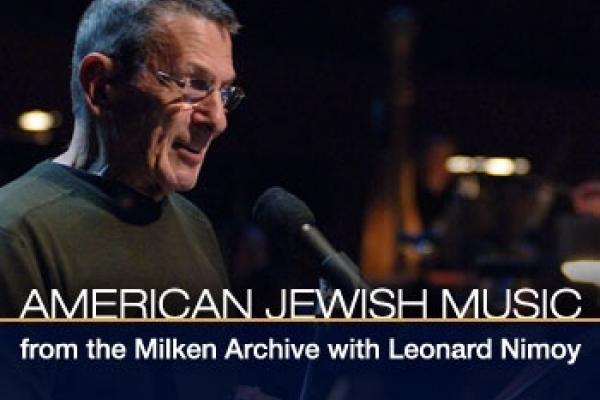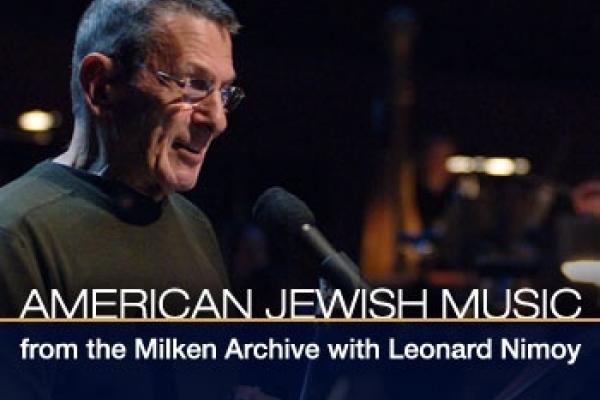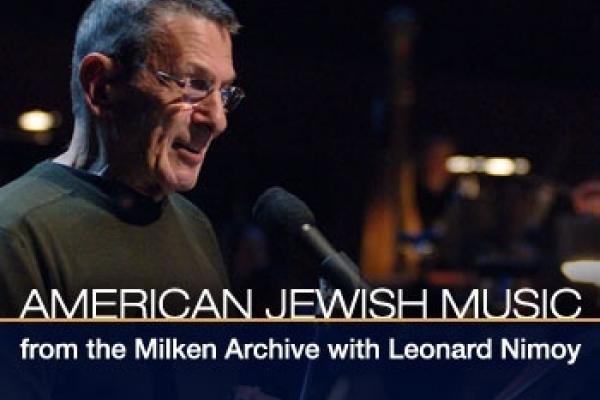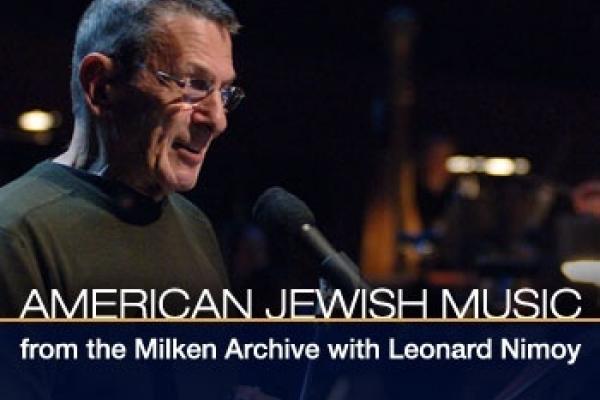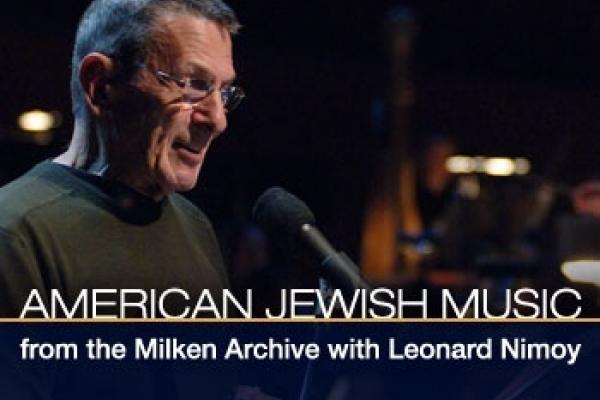Episode 4: Yiddish Theater
Click on the ![]() icon on the top-right of the video to access the full playlist.
icon on the top-right of the video to access the full playlist.
A foray into the golden age of the American Yiddish theater, with songs by Sholom Secunda, Alexander Olshanetsky, Abraham Ellstein, Abe Schwartz, Ilia Trilling, Solomon Shmulevitsh, and Joseph Rumshinsky.
Episode Transcript
Leonard Nimoy
For over a century, Broadway has been synonymous with musical theater in New York. For hundreds of thousands of Eastern European Jews in the early twentieth century, another boulevard beckoned, with musical comedies, melodramas, operettas, and vaudeville in the Yiddish language – Second Avenue. Like Broadway, it gave birth to songs that lived far beyond the productions from which they came. Yiddish songs also emerged from film and radio. Many of them are still remembered today.
Hello, I’m Leonard Nimoy. Welcome to another program in a 13-part series that celebrates three and a half centuries of uninterrupted Jewish life in the United States through music, as documented by the Milken Archive of American Jewish Music, and issued on the Naxos label. On today’s program: popular Yiddish theater music.
Gerard Schwarz, Music Director of the Seattle Symphony and a member of the Milken Archive’s Editorial Board, looked back on the era of the Yiddish theater with music historian and musicologist Neil Levin.
Gerard Schwarz
The Yiddish musical theater is something that we know of in the United States coming from an early part of the 20th century on Second Avenue, the famous Second Avenue Theaters. They were hugely successful. Many theaters, many composers, performers, many shows a week. I mean, extraordinary theatrical time in New York. Why did it exist with such an incredible success and why do we know so little about it now?
Neil Levin
Well, the kind of theater we're talking about, the musical theater we're talking about, it was mass popular entertainment for Yiddish speaking immigrant era Jewry and maybe their next generation. This was not artistically sophisticated, but there is also the Yiddish Art Theater. It's very important that we always keep in mind that the popular Second Avenue was not the only form of Yiddish stage writing, but the mass entertainment, the mass immigrant experience outlet was Second Avenue and its guises in other cities. So for the masses of Yiddish speaking Jews who had come from Eastern Europe and their next generation, and maybe even their next, the theater was entertainment. And the subjects often were very relevant to their immigrant experiences.
Leonard Nimoy
The Artistic Director of the Milken Archive, Neil Levin.
Because the audience for the Yiddish theater consisted largely of immigrants and their families, the subject matter of the shows often related directly to the trials, tribulations, adjustments, and comic situations of the immigrant experience. One of the most famous – in Yiddish revues and vaudeville, and on records and radio – is called “Di Grine Kuzine.”
Neil Levin
We talk about immigrant situations. For example, a song like “Di Grine Kuzine”, the green meaning fresh off the boat, not acclimated yet, a newcomer, a greenhorn. Di Grine Kuzine, the Greenhorn Cousin, here, is sung by Joanne Borts in a very popular type of voice, which is very appropriate to this song. It's a funny song, but also has an immigrant sensibilities. It's hard to understand today about someone who came looking with such hope to America and being able to earn a living and then couldn't earn a living so easily. I worked hard and hard and worked day in and until at the end of her life, she says, The Hell with Columbus's Big Land. I've ruined my life working hard here just as I would have anywhere else.
Leonard Nimoy
The bandleader Abe Schwartz was a recording artist who became celebrated in Jewish music for two “hits” in 1917 – dance tunes called a “bulgar” and a “sher.” Some of his recordings are still available today. His is credited with writing this song about an immigrant’s disillusionment with the unexpectedly hard life in America, which she had thought would be an easy path to comfort. It is emblematic of music that has endured long after the passing of its immediate social context. Here is mezzo-soprano Joanne Borts to sing “Di Grine Kuzine” with the Vienna Chamber Orchestra conducted by Elli Jaffe.
Di Grine Kuzine by Abe Schwart
Leonard Nimoy
“Di Grine Kuzine,” sung by Joanne Borts, with Elli Jaffe conducting the Vienna Chamber Orchestra, a Milken Archive recording issued on the Naxos label.
Leonard Nimoy
Some Yiddish songs even crossed over to become hits among the American public—and in one case, throughout the Western world. It probably is still the most famous Yiddish popular song of all time: “Bay Mir Bist Du Sheyn,” – “To Me You Are Beautiful.” It comes from a full-length Yiddish theater production, “M’ken lebn [“lebm”] nor m’lost [“m’lawst”] nisht,” or “I Wonder If I Could.” It was first recorded in an English adaptation by the Bagelman Sisters – later known as the Barry Sisters. It became a pop hit in a version recorded by the Andrews Sisters, among many other performers, including Benny Goodman and his orchestra. The song was written by Sholom Secunda, one of the four most-remembered song-writers of the American Yiddish theater, as Neil Levin explains.
Neil Levin
The fourth probably is the best remembered today, and that's Sholom Secunda. And Secunda also lived to a ripe old age, and he was also very prolific. He wrote a lot of synagogue music, but much more of that was later in life, especially for Richard Tucker. He did all of Richard Tucker's cantorial arrangements and choral arrangements and compositions for him. But even though Secunda always claimed throughout his life that he really would like to get out of the theater and be a classical composer, I think this is what he loved and this is probably the greatest part of his work.
Leonard Nimoy
Simon Spiro sings two songs by Sholom Secunda – “Bay Mir Bist Du Sheyn,” and “Mein Yiddishe Meydele,” or “My Dear Jewish Girl,” from the show “Zayn Yiddishe Meidl.”
Great Songs of the Yiddish Stage, Volume 2
Leonard Nimoy
“Mein Yiddish Meydele,” and before that “Bay Mir Bis Du Sheyn” – two songs of the Yiddish theater by Sholom Seconda, sung on a Naxos CD from the Milken Archive by Simon Spiro.
Leonard Nimoy
A recurring theme among sentimental Yiddish theater and popular songs is children’s neglect of aging parents. One of the most famous is “A Brivele der Mamen,” “A Letter to Your Mother,” by a successful if less widely remembered songwriter named Solomon Shmulovitz (SHMUL – eh – vitch). It tells of young man leaving Europe – and his mother – for a new life in Amierca. His mother pleads that he remember to write letters to her, to ease the bitter pain of separation. But he never does, and one day he receives word that it is too late. He learns that his mother’s last request had been for him at least to remember to recite the Kaddish prayer in her memory, as a son does for a parent. In a new Naxos recording made especially for the Milken Archive, Elizabeth Shammash sings “A Brivele der Mamen.”
A Brivele der Mamen by Solomon Smulevitz
Leonard Nimoy
“A Brivele der Mamen” – “A Letter to Your Mama” – sung by mezzo-soprano Elizabeth Shammash. Elli Jaffe led the Vienna Chamber Orchestra, from a Naxos release.
Leonard Nimoy
Another less-well-known songwriter, who was quite popular in the heyday of Second Avenue, is Ilia Trilling. He was active in both New York and Chicago – a reminder that there were once flourishing Yiddish theaters not only in Manhattan, but also in Brooklyn, the Bronx, and in other cities like Chicago, Philadelphia, and Los Angeles. Trilling came to the United States in 1929, and composed dozens of hit songs both for full-length Yiddish theatrical productions and as “singles.” His love duet “You Shine Like the Sun” – “Du shaynst vi di zun” – was published in 1941. Robert Bloch, tenor, and Nell Snaidas, soprano, sing it with the Vienna Chamber Orchestra, again led by Elli Jaffe.
Du shaynst vi di zun by Ilia Trilling
Leonard Nimoy
“Du shaynst vi di zun” -- “You Shine Like the Sun” – sung by Nell Snidas and Robert Bloch, with the Vienna Chamber Orchestra, Elli Jaffe, conducting.
Leonard Nimoy
Among the numerous songwriters for the Yiddish theater, four loom large, as Neil Levin – Artistic Director of the Milken Archive – tells Gerard Schwarz.
Neil Levin
There were many, many songwriters and composers who made important contributions to the American Yiddish theater, but probably there are four names that stand out as the most prolific and the best known and are known to this day, even way beyond the Yiddish cultural milieu. Those names are Sholom Secunda, Abraham Ellstein, Joseph Rumshinsky, and Alexander Olshanetsky. There were many, many others, but those probably could be considered the big four.
Gerard Schwarz
Can you give us a little sketch of each one of them?
Neil Levin
I'll start with the saddest case as Olshanetsky said because he died so young, of all of them, certainly of those four, he was the greatest melodist. I think his melodies turns of phrases and so forth are the most interesting. Like many of them, he was an accomplished musician in Europe. Sometimes people assume, Well, it's a popular theater for the mass entertainment, and they couldn't even read music, maybe. It's all false, just as it's false about a lot of the great jazz players from three, four generations ago. Olshanetsky is a perfect case of it. He came from Europe where he conducted seriously all over. Among his most famous songs was, "Ikh hob dikh tsufil lib", I love you too much. When he died at this memorial service for him, there was a huge banner which said, "We loved you too much."
Leonard Nimoy
Here are three songs by Alexander Olshanetsky, sung by Simon Spiro and Amy Goldstein: “Nu, Zog Mir Shoyn Ven” – “Tell Me When, Already”; “Eyn Kuk Af Dir” – “One Look at You”; and perhaps his most enduring song, “Ikh Hob Dikh Tsufil Lib” – “I Loved You Too Much.”
Great Songs of the Yiddish Stage, Volume 2
Leonard Nimoy
Three songs by Alexander Olshanetsky, concluding with his beloved melody “Ikh Hob Dikh Tsufil Lib” – “I Loved You Too Much” – sung by Amy Goldstein. She was joined by Simon Spiro in the two previous songs, “Nu, Zog Mir Shoyn Ven” – “Tell Me When, Already”; and “Eyn Kuk Af Dir” – “One Look at You.” Elli Jaffe led the Vienna Chamber Orchestra in a performance available on the Naxos label.
Leonard Nimoy
You’re listening to a program of Yiddish theater songs from the Milken Archive of American Jewish Music. I’m Leonard Nimoy. There is a historical stylistic connection between Vienna and the music of the popular Yiddish theater, as Milken Archive Artistic Director Neil Levin explains.
Neil Levin
In many ways, the musical foundations for Second Avenue came from Viennese light operetta. That's probably one of the reasons why the Viennese Orchestra took to this right away. I mean, the very first rehearsal, the Vienna Chamber Orchestra just took off. The players looked at each other as if to say, with smiles. None of them were Jews, not a single one. They looked at each other as if to say, Oh, yeah, we get this. They loved it.
Leonard Nimoy
Neil Levin next introduces another of the four great Yiddish songwriters in America.
Neil Levin
Abe Ellstein wrote one song that became very well known in a car on the way to the radio station for it to be performed. Ellstein was probably the most musically advanced of the four in his own training and so forth. He was a Juilliard graduate. I think he was the most musically sophisticated. He was also a very accomplished pianist as well as conductor, of course, too. But he accompanied Yossele Rosenblatt, the famous canter, on his tours to Europe in the 1920s.
Leonard Nimoy
Here are three songs by Abraham Ellstein from the 1939 Yiddish film “Mamele,” or “Little Mama,” which starred Molly Picon. Amy Goldstein sings “Abi Gezunt” – “So long as You’re Healthy”; “Mazl,” or “Luck,” is performed by Elizabeth Shammash; and Robert Bloch is heard in the love song “Ikh Zing,” – “I Sing.”
Great Songs of the Yiddish Stage, Volume 1
Leonard Nimoy
The Vienna Chamber Orchestra under Ellie Jaffe accompanied Robert Bloch in “Ikh Zing,” – “I Sing”; Elizabeth Shammash in “Mazl,” or “Luck”; and Amy Goldstein in “Abi Gezunt” – “So long as You’re Healthy”…three songs from the Yiddish film “Mamele” composed by Abraham Ellstein, from a Milken Archive recording on the Naxos label.
Leonard Nimoy
This two-hour program, part of a series from the Milken Archive of American Jewish Music, is devoted to songs from the Yiddish theater, vaudeville, film, and radio. In the second half of the program we’ll hear more music by Abraham Ellstein, as well as songs by another luminary of Second Avenue, Joseph Rumshinsky. I’m Leonard Nimoy. This is the W-F-M-T Radio Network.
Leonard Nimoy
Welcome back to this program from the Milken Archive of American Jewish Music. I'm Leonard Nimoy. Today, we're listening to music in the Yiddish language drawn from Vaudeville, musical comedy, radio, and film for the first half of the 20th century. Neil Levin, artistic director of the Milken Archive, has this note about Yiddish film.
Neil Levin
A number of Yiddish films were made. There was kind of a little cottage industry of Jewish filmmaking, purely entertainment filmmaking in Yiddish films. I think what we're talking about here is films of plays. In other words, a film that is essentially a play with music in it. Abe Ellstein, one of the big four songwriters, did several films, score and songs and so forth. Today they look primitive. A lot of films in the 30s look primitive in terms of the sets and costumes and some of the melodramatic acting and the "oy veys" and the forehead slapping and so forth. But the songs are there.
Leonard Nimoy
One of the most famous roles taken by the musical-comedy star Molly Picon was the title role in the 1936 film “Yidl mitn fidl” – “A Little Jew with His Fiddle” – in which a young woman poses as an itinerant male musician. Here is the Abraham Ellstein song “Oy, mame, bin ikh farlibt,” – “Oh, Mama, Am I in Love” – from that film, followed by another Molly Picon song called “Oygn”, or “Eyes,” for which Picon herself wrote the lyrics. Both are sung by Elizabeth Shammash.
Leonard Nimoy
We’ll also hear three other songs by Ellstein: “Der Alter Tsigayner,” or “The Old Gypsy”; “Der Nayer Sher,” or “The New Dance Tune”; and, “Ikh vil es hern nokh amol fun dir” – “I Want to Hear It Once Again from You” …with Simon Spiro and Amy Goldstein. All of these songs were written by Abraham Ellstein.
Great Songs of the Yiddish Stage, Volume 1
Leonard Nimoy
Five songs by one of the great composers for the Yiddish stage and film, Abraham Ellstein, concluding with “Ikh vil es hern nokh amol fun dir” – “I Want to Hear It Once Again from You,” from the 1946 romantic musical comedy “Ikh bin farlibt” – “I’m in Love” -- sung by tenor Simon Spiro and soprano Amy Goldstein. The selections began with two songs associated with Molly Picon -- “Oy, mame, bin ikh farlibt,” – “Oh, Mama, Am I in Love” – from the film “Yidl mitn Fidl,” and “Oygn”, or “Eyes.” We also heard “Der Alter Tsigayner,” or “The Old Gypsy”; and “Der Nayer Sher,” or “The New Dance Tune.” The mezzo-soprano was Elizabeth Shammash. All were accompanied by the Vienna Chamber Orchestra, Elli Jaffe, conducting.
Leonard Nimoy
This program of Yiddish popular and theatrical music is part of a series from the Milken Archive of American Jewish Music. I’m Leonard Nimoy. We’ll conclude with songs by the composer Joseph Rumshinsky. Neil Levin, Artistic Director of Milken Archive, talks about Rumshinsky, and about songs by various songwriters written for live radio programs.
Neil Levin
Joseph Rumshinsky came also from Europe. He came from Poland, very accomplished in many areas. Rumshinsky, like many of the others, wrote Synagogue music as well as theater music, but his first activity was theater. Rumshinsky was more than just a composer and songwriter for theater. He was more of an impresario, I think, than the others. He really had power. "Rummy," they called him. His son, who only passed away a few years ago, the age of 90-something, Murray Rumshinsky, was also involved in the theater and of course, in radio. Remember that a lot of the songs that we talk about as Yiddish theater songs are not necessarily out of the theater per se, that is from plays. Really, what we should be saying is stage songs, because then you got three kinds of stages. The stage of the Yiddish theater, meaning a song from a show, from a full length show with a single plot and so forth. Or they could be individual songs written for reviews or Yiddish vaudeville, which actually preceded the real theater. The third is radio. Radio not only programmed and made famous dozens and dozens, hundreds of songs that were hit songs from certain plays in any given year on Second Avenue.
Neil Levin
But it also engendered new songs because there were all day long, seven days a week, radio broadcasts, especially in the New York area, but other cities as well, devoted to Jewish music. And it wasn't just one or two, it was many stations. In Brooklyn alone, there were stations in New Jersey, New York, Chicago, the Planters Peanut Hour, the Maxwell House Hour in New York. Maxwell House even had their own choir called the instant Maxwell House Choir, which did cantorial things, too, and so forth. These were all jobs for people.
Leonard Nimoy
The artistic director of the Milken Archive, Neil Levin. Joseph Rumshinsky arrived in the United States in 1904, and soon became the leading composer for a burgeoning genre of popular Yiddish theater, as well as an important conductor and impresario on Second Avenue. He wrote more than a hundred Yiddish operettas, and probably more than a thousand songs – including numerous memorable ones both comic and sad, romantic and nostalgic.
Leonard Nimoy
The Milken Archive has made new recordings of many of his Yiddish theatrical songs, issued on the Naxos label. Here is a selection of them performed by Amy Goldstein, Bruce Adler, Nell Snaidas, Joanne Borts, Benzion Miller, Simon Spiro, and Robert Bloch.
Great Songs of the Yiddish Stage, Volume 3
Leonard Nimoy
Songs for the stage by Joseph Rumshinky, one of the great composers of Yiddish theatrical songs. The artists heard in these Milken Archive recordings on the Naxos label were Amy Goldstein, Bruce Adler, Nell Snaidas, Joanne Borts, Benzion Miller, Simon Spiro, and Robert Bloch, all under the direction of Elli Jaffe.
Leonard Nimoy
You’ve been listening to another program in a 13-part series devoted to the recordings of the Milken Archive of American Jewish Music, currently being issued on CD by the Naxos label. The Milken Archive was created by Lowell Milken, chairman of the Milken Family Foundation. Neil W. Levin is Artistic Director.
Featured Speakers
 Neil Levin |  Gerard Schwarz |
|---|
Featured Tracks
| Abe Schwarz: Di grine kusine |
| Sholom Secunda: Bay mir bistu sheyn; Mayn yidishe meydle |
| Solomon Smulevitz: A brivele der mamen |
| Ilia Trilling: Du shaynst vi di zun |
| Alexander Olshanetsky: Nu, zug mir shoyn ven; Eyn kuk af dir; Ikh hob dikh tsufil lib |
| Abraham Ellstein: Abi gezunt; Mazl; Ikh zing; Der alter tsiayner; Der nayer sher; Ikh vil es hern nokh amol |
| Joseph Rumshinsky: A bisl libe un a bisl glik; Dir a nikl, mir a nikl; Du bist dos likht fun mayne oygn; Es tsit, es brit; Fifty-fifty; Hamavdil; In a kleyn shtibele; Oy, is dos a meydl |
About the Series
| Produced in conjunction with the WFMT network and broadcast on radio stations throughout the U.S., American Jewish Music from the Milken Archive with Leonard Nimoy is a 13-part series of two-hour programs featuring highlights from the Milken Archive’s extensive collection of the musical recordings. Episodes include interviews and commentary with Lowell Milken, Neil W. Levin, and Gerard Schwarz. Radio stations interested in broadcasting the series should contact media@milkenarchive.org. |
Date: May 15, 2023
Credit: Milken Family Foundation
Related Tags:
Abraham Ellstein Alexander Olshanetsky Joseph Rumshinsky Leonard Nimoy Sholom Secunda Yiddish Theater
